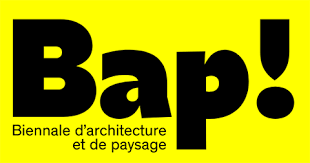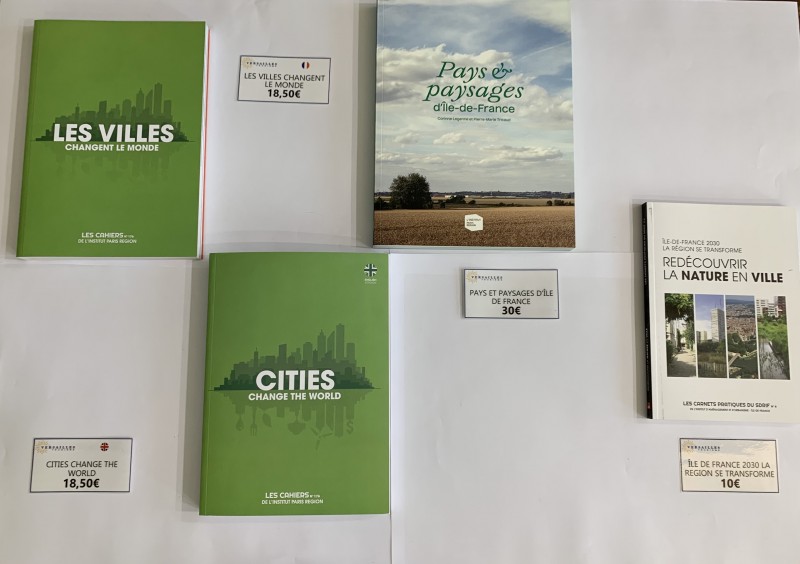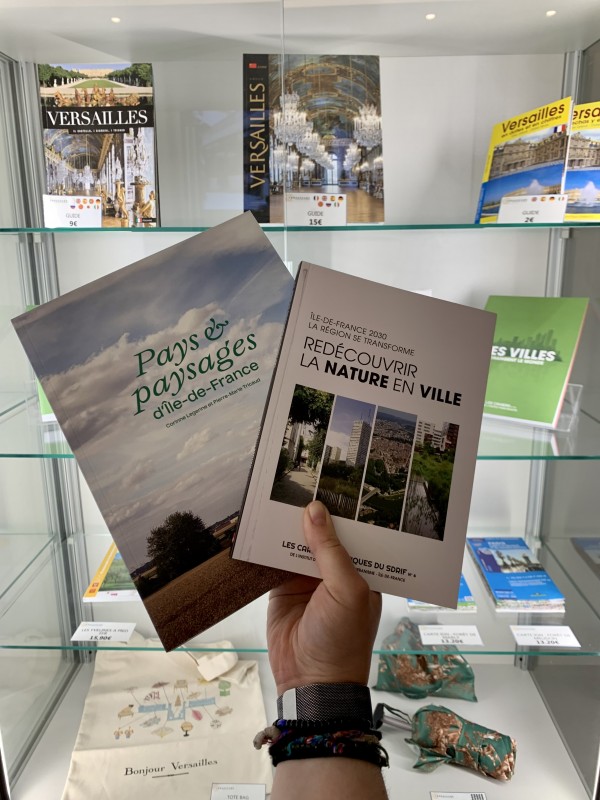2022 Architecture and Landscape Biennial in Versailles
Enjoy the second edition of the Architecture and Landscape Biennial, a major event for the Île-de-France Region which, since the beginning of its term of office, has been pursuing a development and urban planning policy that is both innovative and sustainable, ambitious and focused on man, nature and the city.
Our BAP shop products
Discover new books on the theme of architecture and art in the city!
Published by Fayard:
Bêtes de villes - Nicolas Gilsoul (pocket size) - 9€ -
Will the zebra mussel save New York? Will the scorpion Tityus serrulatus terrorise the inhabitants of São Paulo? Will the kangaroos frolic in the forest of Rambouillet? Did you even know that all these animals live so close to home? In the midst of the biodiversity crisis, our cities have become hybrid jungles where many more creatures cross paths than in our forests.
Welcome to the 33,000 illegal wild boars in Berlin's parks, the leopards of Bombay's suburbs, the coyotes of Chicago and the cougars of Mulholland Drive. Some have mutated, their behaviour or physique transformed to survive the city. The Brooklyn mouse resists heavy pollutants, the Amsterdam snail fights the urban heat island, and the East Coast swallow reduces its wings to avoid skyscrapers. Through 1,001 stories of urban animals, the architect Nicolas Gilsoul offers us an erudite bestiary of our territories and encourages us to reconnect with living things.
Chlorophylle & bêtes de villes - Nicolas Gilsoul - €19
Cities were our kingdom. Then we came across the animals. Birds, butterflies, foxes, wild boars, hedgehogs and kangaroos appeared and became city dwellers like us. Voluble but silent, Her Majesty Chlorophyll walks over the city. Host, cook and architect, the Plant enters the scene.
Does the sacred lotus of Bangkok navigate better on asphalt rivers? Will the Parisian bean warn us in time about air pollution? In Tel Aviv, do noisy beaches really deafen the night beauties? Will urban goats climb parking trees? And will the king of Mexican butterflies make a comeback in our cities along with the goldenrod? Chlorophylle and her beasts educate us. On the pavement, they talk about architecture and geopolitics, globalisation and local roots, inventions and innovations, culture, history, hope. And love. Thanks to these new natural stories, the architect Nicolas Gilsoul takes us on a jubilant journey to the land of the Living. His playful and joyful school underlines the fragility of our world and reenchants our cities.
Welcome to the 33,000 illegal wild boars in Berlin's parks, the leopards of Bombay's suburbs, the coyotes of Chicago and the cougars of Mulholland Drive. Some have mutated, their behaviour or physique transformed to survive the city. The Brooklyn mouse resists heavy pollutants, the Amsterdam snail fights the urban heat island, and the East Coast swallow reduces its wings to avoid skyscrapers. Through 1,001 stories of urban animals, the architect Nicolas Gilsoul offers us an erudite bestiary of our territories and encourages us to reconnect with living things.
Chlorophylle & bêtes de villes - Nicolas Gilsoul - €19
Cities were our kingdom. Then we came across the animals. Birds, butterflies, foxes, wild boars, hedgehogs and kangaroos appeared and became city dwellers like us. Voluble but silent, Her Majesty Chlorophyll walks over the city. Host, cook and architect, the Plant enters the scene.
Does the sacred lotus of Bangkok navigate better on asphalt rivers? Will the Parisian bean warn us in time about air pollution? In Tel Aviv, do noisy beaches really deafen the night beauties? Will urban goats climb parking trees? And will the king of Mexican butterflies make a comeback in our cities along with the goldenrod? Chlorophylle and her beasts educate us. On the pavement, they talk about architecture and geopolitics, globalisation and local roots, inventions and innovations, culture, history, hope. And love. Thanks to these new natural stories, the architect Nicolas Gilsoul takes us on a jubilant journey to the land of the Living. His playful and joyful school underlines the fragility of our world and reenchants our cities.
Institut Paris Région :
Pays et Paysages d'Ile-de-France by Corinne Legenne and Pierre-Marie Tricaud - €30
On the fringes of Paris and the dense urban area are picturesque landscapes of fields, forests, green hills, meanders and peaceful villages, once celebrated by painters and poets. One hundred thousand hectares of fertile land swallowed up by tarmac and concrete over the last fifty years would almost make you forget that three quarters of the Île-de-France is still rural. As we travel through these countries, sometimes of valleys, sometimes of plateaus or plains, we rediscover an extraordinarily diverse metropolitan-capital landscape: the Paris conurbation, the Marne meldoise, the Seine mantoise and the Seine melunoise for the most urban; the French Vexin, the Plaine de France, the Brie, the Gâtinais, the Hurepoix, the Yveline... for the most rural. These territories, with their sometimes blurred contours, retain a strong identity, rooted as they are in history and, above all, geography. For the essence of the countries is geographical. The relief, the waterways, the geology, the geomorphology, the land use, the agrarian structures - in a word, the landscape - determine these age-old entities, which are still identifiable today, if you look at them with your eyes.
Ile de France 2030 : La Région se transforme, Redécouvrir la nature en ville -10€ -
Rediscovering nature in the city. Why should we do so? Why? How? The aim of this practical notebook is to highlight the innovative actions and projects implemented to help reconcile human beings with their urban environment.
The multiplicity of actions presented, from urban planning documents to initiatives on various themes, at different scales, demonstrates that these changes are not only possible but already well underway. This book is an invitation to an "environmental excellence" in urban planning and management. It is up to each of us to follow suit and share our know-how to build a sustainable city.
Cities change the world - 18.50€ - (also available in English)
According to the United Nations, almost two-thirds of the world's population will live in urban areas by 2045. Currently estimated at 4.2 billion, urban dwellers are expected to number 5 billion in 2030 and 6.7 billion in 2050.
At the heart of global financial and migratory flows, metropolises shape societal values and global lifestyles. They are the showcases of the world's changes, creating economic wealth and technological innovations.
Since the beginning of the third millennium, their centres have been regenerating and becoming denser, while the peripheries are spreading out. But their long-term development model raises questions. Victims of their own success, will the metropolises end up becoming unlivable? What will be the social and environmental sustainability of these urban areas? How can attractiveness and quality of life be combined for all?
From New York to Paris Île-de-France, from Tokyo to Copenhagen, from Singapore to Medellin, metropolises at all scales are inventing new development paths to combine economic competitiveness, urban regeneration, social inclusion, energy frugality and climate resilience. And in doing so, they are changing the world.
This issue of the Cahiers highlights some particularly inspiring strategies and initiatives to meet the fundamental challenges of (Very) Greater Paris.
Terres de Seine, Landscapes and Heritage in the heart of Yvelines - by the Île-de-France Region in partnership with the CAUE des Yvelines,
the CAUE des Hauts-de-Seine and the CAUE du Val d'Oise - Éditions Lieux Dits - €27
From the confluence of the Oise to the gates of Normandy, the meanders of the Seine have long inspired the gaze of "image makers". This book is not without a duty to Monet's brush and Maupassant's pen, preceding the generations of surveyors who, right up to the present day, have wanted to pass on their passion for a territory in constant change, soon to be conquered by urban expansion. This work therefore bears witness to both the permanence and the contemporary upheavals that contribute to shape the landscape. The work of the inventory services of the Ile-de-France Region and that of the Observatoire photographique du paysage de la vallée
de la Seine reveal here the little-known riches of a territory of nearly eighty communes in the heart of the Yvelines. All the inhabitants of Ile-de-France perceive from the motorway these visual landmarks such as the chimneys of Porcheville, the towers of the collegiate church of Mantes or the Peugeot water tower in Poissy.
But there are uninhabited islands, wooded areas as far as the eye can see, open fields, vineyards, isolated farms, belvederes, factories,
villages that remain largely unknown. These landscapes, these architectures, this heritage studied by historians and curators are highlighted here thanks to the exceptional photographic work carried out
by Ambroise Tézenas, Jérémie Léon, Laurent Kruszyk and François Adam as part of the Observatoire photographique du paysage
Observatoire photographique du paysage de la vallée de la Seine. This book is published on the occasion of the second Biennale of Architecture and Landscape (BAP!) of the Ile-de-France Region, which is devoting three exhibitions to this work.
The Bap's Program of Events
From April 12 to May 20: Workshop : From CLOTH to CLOTHING
Through the use of textile as a visible material, the workshop proposes to probe the invisible, to question the space that links the human body to a given environment.
Petite Ecurie, Ecole nationale supérieure d'architecture de Versailles, place des Manèges
From May 13 to July 13: Exhibition Between Earth and City, the power of trees in images
Silent guardians, privileged observers of our lifestyles and sentinels of our fragile ecosystems: trees are the stars of this photographic exhibition
Petite Ecurie, wall of the Maréchalerie
Petite Ecurie, wall of the Maréchalerie
From May 14 to July 10: Exhibition Territories in transformation
The exhibition imagines the public space of tomorrow by looking at the movements of the earth and the use we make of it. Reconversion of former industrial sites, requalification of agricultural and peri-urban edges, decline of commercial areas and their gigantic parking lots...
Future eco-district of Gally
Future eco-district of Gally
From May 14th to July 10th : Workshop Invitation to the work
Accompanied by the Coloco collective and their guests, this collective and convivial dynamic aims at establishing new links between the living, human and non-human, to form a living work: "Le Potager des autres".
King's Kitchen Garden, Ecole nationale supérieure de paysage
King's Kitchen Garden, Ecole nationale supérieure de paysage
From May 21 to July 10: Exhibition Guided tour of the Presence of the living
With La Préséance du vivant, the Ecole nationale supérieure de paysage invites you to explore contemporary landscape production, where ecosystems are at the center of projects.
King's Kitchen Garden, Ecole nationale supérieure de paysage
King's Kitchen Garden, Ecole nationale supérieure de paysage
Tuesday, May 24: Round table: What place for raw earth in construction in Île-de-France?
The building and public works sector (BTP) is one of the most emitting greenhouse gases. In 2018, it accounted for 19% of greenhouse gas emissions on a national scale. The use of biosourced and geosourced materials represents a major lever to achieve the objectives of carbon neutrality. Raw earth, geosourced, although not renewable, has many advantages for construction, but under what conditions?
Old Central Post Office
Old Central Post Office
From May 28 to July 10: Exhibition Guided tour Project(s) Earth(s)
The Ecole nationale supérieure de paysage invites you to put yourself in the shoes of a student who discovers how to "take care of the soil" in landscape projects with the exhibition Projet(s) Terre(s)
King's Kitchen Garden, Ecole nationale supérieure de paysage
King's Kitchen Garden, Ecole nationale supérieure de paysage
Saturday, May 28 and Saturday, June 4 at 2 pm: Conferences organized by ARVHA as part of the Women Architect Award
In the auditorium of the school, 2 workshops led by Catherine Guyot, President of ARVHA
Petite Ecurie, Ecole nationale supérieure d'architecture de Versailles, place des Manèges
Petite Ecurie, Ecole nationale supérieure d'architecture de Versailles, place des Manèges
Tuesday, May 31 at 4:30 pm: Round table: The landscapes of the Seine Valley, or when a river shapes a base
The Seine is THE river of the Île-de-France and Normandy regions, which contributes in large part to the landscape identity of these two regions and links them together. Urban or rural, harmonious, ordinary or ungainly, its landscapes question our relationship to the earth and to water, two of the essential elements of life.
Old Central Post Office
Old Central Post Office
Tuesday, June 7 at 4:30 pm: The resource - soil, at the heart of renaturation issues
Île-de-France is a region where little is artificialized today (compared to other French regions) but where much was artificialized in the past. Artificialization and renaturation remain rather vague notions, which call for several representations or interpretations, just like nature. The round-table will address two main sets of questions: what meaning should be given to renaturation in Île-de-France? Which actions would be the most effective or would bring the most co-benefits?
Old Central Post Office
Old Central Post Office
Tuesday, June 14 at 4:30 pm: Round table - Circular development
Faced with the scarcity of resources, greenhouse gas emissions, and the massive production of waste, the circular economy is in the air of time. It opens a new horizon for the development of territories, for construction and public works. This round table aims to pursue a double objective: to exchange with local authorities that are pioneers in the commitment to a more circular development. What studies have been conducted? What projects and strategies have been implemented? What tools are available to territories to deploy circular development?
Old Central Post Office
Old Central Post Office
Written by Adélaïde
Published on Tuesday May 31, 2022 at 14:27




